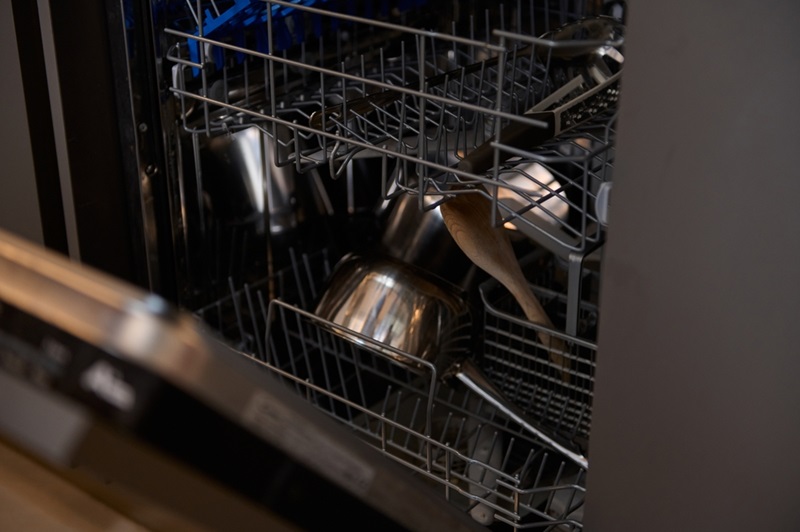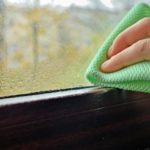Opening your dishwasher’s door to be greeted by a decaying aroma is as unappealing as it gets!
Given that the dishwasher’s job is to clean your dirty plates and glasses, it should smell fresh and sanitary. Not rancid.
So, how do you stop a dishwasher from smelling funky? The easiest way to eradicate foul smells is to find the source of the aroma and thoroughly clean the appliance. Read on to learn more.
Step 1: Find the Source of the Problem
Think about what type of smell you’ve got. For example:
- Rotting or dirty smell – This is most likely caused by a build-up of grease, food, and soap/mineral deposits clogging up the dishwasher. It could also be a sign of a drainage issue, like a bent or detached hose.
- Burning or melting odour – This could be a sign that some parts are malfunctioning or that plastic is/has melted inside the machine.
- Mould – The appliance creates a warm, moist environment where mould grows. If left untreated, it will take over.
Now you know what’s likely causing the smell, get rid of it accordingly.
Tip: Check your user manual to see if your appliance has “known stinky issues”. The manufacturer might tell you what type of smelly problems you can expect and how to fix them. If you don’t have a manual, go to the manufacturer’s website and download a copy.
Step 2: Find a Solution and Treat Your Odour-y Issue
Using household products
Follow the steps below to thoroughly clean your dishwasher:
- Make sure your dishwasher is empty. The less stuff you have in the appliance, the easier it will be to clean.
- The drain filter/trap’s primary purpose is to catch crumbs of food before they go out through the drain hose. Needless to say, it takes a hammering every time your dishwasher is on and collects a load of gunk. In the warm, moist environment the debris becomes a breeding ground for bacteria. To clean the drain filter, remove the detachable piece (see your user manual if you’re unsure how to do this), and clear the grime away by holding it under hot running water. Use a soft toothbrush to brush toughened grime off the filter. When the drain filter is out of its slot, clean the slot out. You can use a soft toothbrush dipped in warm water to tease dirt from the area. Consider using a drain snake to dislodge deep-down dirt from the drain Replace the drain trap when you’re done.
- To clean out and deodorise your dishwasher, pop a cup filled with white vinegar on the top rack of your machine and run a long, hot cycle. The acid will help break down grime and odours. Concerned about the pungent vinegar aroma? Swap the vinegar for a cup of lemon juice instead.
- After the cycle has ended, pour a cup of bicarbonate of soda over the dishwasher’s floor and run a short, hot cycle. The bicarb will act as an extra tough odour neutraliser.
- By now, the dishwasher should be much cleaner and aromatically pleasing. But that doesn’t mean the cleaning session is over! It’s now time to wash the intricate parts of the appliance to ensure it’s extra clean! Grab a cloth soaked in warm, soapy water, wring it out, and wipe down all the walls and door. Use a small, soft toothbrush to work the grime from the tighter nooks. Pay close attention to the rubber seal around the door – it can accumulate dirt and mould. Don’t use too much soap inside the dishwasher – you’ll create too many bubbles, and this lather can clog the appliance. Stick to using damp cloths. In addition, remove the racks from the dishwasher and clean them in the sink using a soft brush and hot soapy water. Allow them to dry, and then replace them. Tip: Don’t use abrasive tools because you will damage the surfaces.
- Mineral deposits typically clog the spray arms, thus hindering the water’s spraying ability. To ensure the water is evenly distributed during the washing cycle, you need to remove the caked-on grime. To do this, remove the spray arms from the dishwasher (see your user manual for exact instructions), then hold each arm under running hot water and use a toothpick to clear the deposits from the holes. You can replace the spray arms when they’re clean.
Using specialised cleaning products
Use an off-the-shelf dishwasher cleaner, like the following, to keep your dishwasher maintained, fresh and scented:
- HG’s dishwasher cleaner and odour freshener can be used fortnightly to clean an empty dishwasher. The formula is tough on hidden dirt and greasy deposits, improves the appliances’ cleaning abilities, and leaves your machine smelling clean, but the odour isn’t overpowering.
- Finish Dishwasher Machine Cleaner is super easy to use. You take off the sticky label at the head of the bottle, turn it upside down and pop it on the bottom rack of your dishwasher. Once you start the cycle, the solution is released and starts breaking down limescale and grease, which can cause lingering odours in the appliance. Moreover, you only have to use Finish’s dishwasher cleaner once every three months.
- Beckmann’s Service-It Deep Clean Dishwasher Cleaner is a two-part product. You pour the cleaning solution into the dishwasher’s detergent compartment (place the excess product on the dishwasher’s floor) and run a hot cycle. Then, you grab the cloth, which is also in the box, to wipe the seal and door of the dishwasher down at the end of the cycle. This extra step is great because it means you’re being even more vigilant and keeping grime and mould away from these troublesome areas!
Remember that even if you use a product like the ones mentioned above to maintain your appliance, you cannot skip other cleaning activities. For example, you must still clean the drain filter at least once a month.
You must also wipe the rubber seal down to keep mould at bay and remove clumps of food if they’re stuck on the machine’s walls or door.
Sort out drainage issues
Drainage issues typically revolve around a bent or detached hose. This can be particularly problematic because dirty water doesn’t effectively empty out of the appliance. Consequently, dirt and gunk get stuck in the pipe and emit a putrid smell.
In addition, a defective drain hose can also leave standing water in the bottom of a dishwasher. If you see a pool of water, assume the hose used to remove the dirty water isn’t functioning as it should.
To check these types of issues, pull the machine away from the wall, then locate and check the hose. You can detach the hose to inspect it further (see your manual for further instructions). If need be, clean the hose by flushing hot water through it. This will clear out any obstructions. When you’re finished, hook the hose back on.
If the drain hose is loose, secure it back in place.
Ensure electrical failures or melting plastic problems are dealt with
Check your machine for loose or singed wires. If you see anything out of the ordinary, stop using the machine.
Handling and repairing wires is a delicate job. So, it’s better to call an engineer to sort the problem out. You can arrange for them to visit and do the repair work at a suitable time.
Don’t use the dishwasher during this time.
In contrast, if you accidentally wash something that isn’t dishwasher-safe, the machine will emit a burning plastic aroma.
In this case, you must remove the melted object and clean the rest of the dishwasher to ensure that no bits are clogged in the system and to neutralise the odour. Follow the steps above to clean and deodorise your dishwasher.
Use dishwasher fresheners to ensure long-lasting freshness
In addition, you could clip a dishwasher air freshener onto a rack inside your dishwashing machine to make it smell fresh and hygienic.
A freshening tool, like Finish’s Dishwasher Freshener, stays in place for up to 60 washes and ensures your appliance has a zesty lemon and lime odour in between cleans.
Step 3: Assess the Stinky Situation
Once you’ve treated your dishwasher, you can assess how the machine smells and looks. At this stage, you can decide whether to re-treat your appliance using the same products, re-treat it using different cleaning solutions, or call an engineer out to delve deeper into the problem.
If you need to call a qualified engineer, you can either contact the dishwasher’s manufacturers, return to the shop where you bought your appliance, or find your own private professional.
Preventative Measures to Consider
Take note of the following points when using a dishwasher so you can keep it cleaner for longer:
- Remove waste food from plates before you load them into the dishwasher.
- Clean specific areas in your dishwasher more often. The filter, for example, needs to be washed at least once a month – don’t leave it too long between cleans.
- Remove chunks of grime from the appliance at the end of each cycle. You don’t want the gunk to build up.
- Use the right cleaning products in your dishwasher. Using the wrong products could damage the appliance.
- Run a cup of white vinegar through your empty dishwasher monthly.
- Deep clean your dishwasher every three months. This is when you remove and clean the individual parts!
- Don’t overload your dishwashing appliance.
- Try to lower mineral deposits further by using water softeners.

Bethan has a passion for exploring, reading, cooking and gardening! When she’s not creating culinary delights for her family, she’s concocting potions to keep her house clean!






